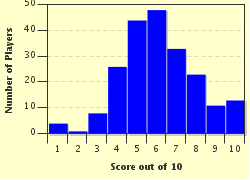Quiz Answer Key and Fun Facts
1. In 1815, one of the largest volcanic eruptions took place. It was so massive, it became one of the few eruptions to be labeled VEI-7. The following year (1816) was one of the coldest in history due to the smoke and ash from the volcano, effectively blocking out much of the sun for that year.
What large volcano erupted in 1815?
2. The Tunguska Event of 1908 was one of the largest impacts in Earth's recorded history. The explosion was so powerful that trees were bent over more than 800 square miles of land. The explosion occurred in the air, above the Podkamennaya Tunguska River in Siberia, Russia.
Though there are many theories as to the cause, what is said to have exploded above this river, causing the devastation?
3. In 1917, two ships collided. The first, the SS Mont Blanc, was a French cargo ship. It crashed into the SS Imo, a Norwegian ship, in a harbor of Canada. At the time, it was the largest man made explosion in history (though it was accidental).
Which city was devastated by the explosion?
4. In 1937, the LZ129 airship known as the Hindenburg caught fire and exploded. Out of 97 on board the airship, 35 were killed in the disaster. The incident occurred in New Jersey, as the airship from Germany was attempting to dock.
What type of airship was the Hindenburg?
5. On August 6, 1945, Hiroshima was bombed by the United States, and only three days later, another bomb was dropped on Nagasaki. These two explosions were enormous, and caused massive damage, killing tens of thousands of innocent people. What was the name of the aircraft that carried the bomb that was dropped on Nagasaki on August 9, 1945?
6. In 1961, a hydrogen bomb was tested in the Soviet Union. The Kuz'kina Mat had such a large blast that even the aircraft that dropped the bomb in testing, 6.5 miles in the air, was almost hit by the explosion. The fireball created by the bomb was not able to hit the ground due to the shock wave created by the explosion.
What was the name of the hydrogen bomb?
7. In 1986, the world watched as the first member of the Teacher in Space Program left the earth in the space shuttle called the Challenger. Unfortunately, things did not go as smoothly as anticipated, and less than two minutes after liftoff, the space shuttle exploded and fell into the Atlantic Ocean. Sadly, there were no survivors from the terrible crash.
The cause of the malfunction was perhaps a "piddly" thing. Which of these items was flawed, and failed, causing a terrible chain of events that eventually caused the shuttle to explode?
8. In April of 1986, much of the north-west Ukraine was evacuated due to the explosion at the Chernobyl Nuclear Power Plant. Radiation was so strong that those around the area, such as those working in recovery, received the equivalent of 50 years worth of the average background radiation (each day, everyone gets a certain amount of radiation absorbed in their system, which is normal; 50 years worth in a few moments is not).
However, Ukraine was not the only country affected by the disaster. Much of Europe felt effects, but which of these countries had the highest level of nuclear fallout?
9. On September 11, 2001, several explosions occurred in New York. Two large towers, known as the Twin Towers of the World Trade Center, were both hit by planes. In Washington DC, the Pentagon was hit. Not long after, part of the Pentagon collapsed and both Twin Towers crumbled to the ground as well.
Four flights were hijacked in order to make the attack. Only three made it to their destination. Which of these flights' hijackers were overcome by passengers, and crashed into a field instead of the intended target?
10. In 2008, something in the sky could be seen from the naked eye; something that happens only every couple hundred thousand years. On March 19, many watched the skies to see a spectacular sight, the GRB 080319B, which occurred billions of years ago, finally reaching earth.
What was the original cause of the explosion, which earth did not see light of until 2008?
Source: Author
salami_swami
This quiz was reviewed by FunTrivia editor
bloomsby before going online.
Any errors found in FunTrivia content are routinely corrected through our feedback system.

